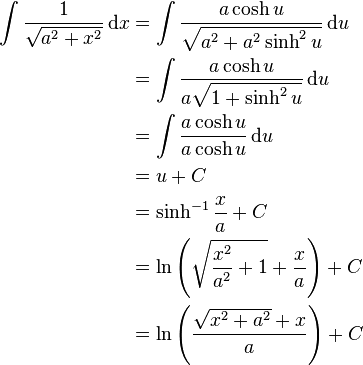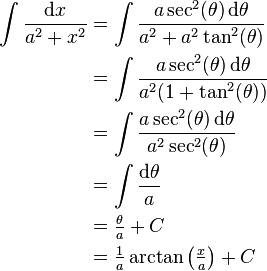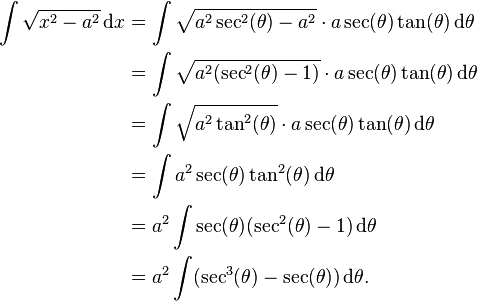Trigonometric substitution
| Wikiversity has learning materials about Trigonometric Substitutions |
| Wikibooks has a book on the topic of: Calculus/Integration techniques/Trigonometric Substitution |
| Calculus | ||||||
|---|---|---|---|---|---|---|
|
||||||
|
||||||
|
Specialized |
||||||
In mathematics, Trigonometric substitution is the substitution of trigonometric functions for other expressions. One may use the trigonometric identities to simplify certain integrals containing radical expressions:[1][2]
Substitution 1. If the integrand contains a2 − x2, let
and use the identity
Substitution 2. If the integrand contains a2 + x2, let
and use the identity
Substitution 3. If the integrand contains x2 − a2, let
and use the identity
Examples
Integrals containing a2 − x2
In the integral
we may use
Note that the above step requires that a > 0 and cos(θ) > 0; we can choose the a to be the positive square root of a2; and we impose the restriction on θ to be −π/2 < θ < π/2 by using the arcsin function.
For a definite integral, one must figure out how the bounds of integration change. For example, as x goes from 0 to a/2, then sin(θ) goes from 0 to 1/2, so θ goes from 0 to π/6. Then we have
Some care is needed when picking the bounds. The integration above requires that −π/2 < θ < π/2, so θ going from 0 to π/6 is the only choice. If we had missed this restriction, we might have picked θ to go from π to 5π/6, which would give us the negative of the result.
Integrals containing a2 + x2
In the integral
we may write
so that the integral becomes
(provided a ≠ 0).
Integrals containing x2 − a2
Integrals like
should be done by partial fractions rather than trigonometric substitutions. However, the integral
can be done by substitution:
We can then solve this using the formula for the integral of secant cubed.
Substitutions that eliminate trigonometric functions
Substitution can be used to remove trigonometric functions. In particular, see Tangent half-angle substitution.
For instance,
Hyperbolic substitution
Substitutions of hyperbolic functions can also be used to simplify integrals.[3]
In the integral  , make the substitution
, make the substitution  ,
,  .
.
Then, using the identities  and
and  ,
,

See also
References
- ↑ Stewart, James (2008). Calculus: Early Transcendentals (6th ed.). Brooks/Cole. ISBN 0-495-01166-5.
- ↑ Thomas, George B.; Weir, Maurice D.; Hass, Joel (2010). Thomas' Calculus: Early Transcendentals (12th ed.). Addison-Wesley. ISBN 0-321-58876-2.
- ↑ Boyadzhiev, Khristo N. "Hyperbolic Substitutions for Integrals" (PDF). Retrieved 4 March 2013.

















